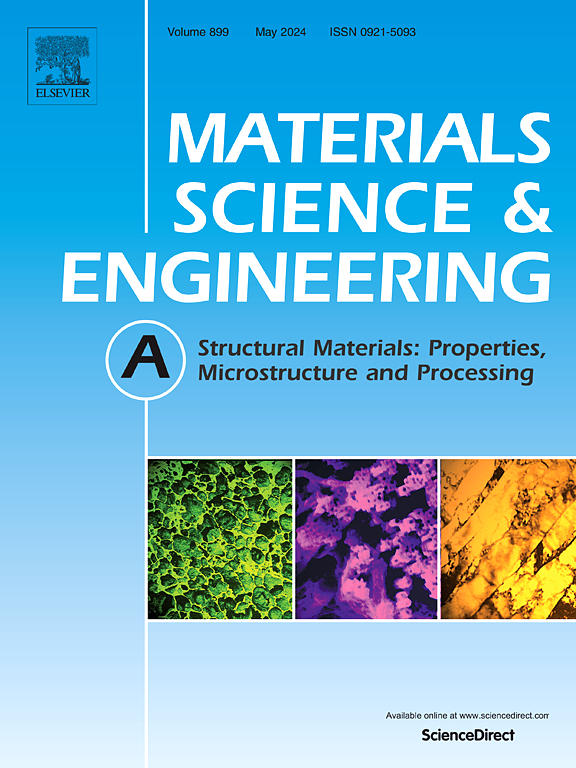在GH4698镍基高温合金中,通过双峰尺寸分布的非均相晶粒和L12-γ′纳米沉淀实现了优异的强度-塑性协同作用
IF 6.1
2区 材料科学
Q1 MATERIALS SCIENCE, MULTIDISCIPLINARY
引用次数: 0
摘要
具有异质微观结构的结构材料提供了独特的强度和延展性组合。在本研究中,采用77 K低温轧制、退火和时效的方法合成了一种由形变晶粒和再结晶晶粒组成的非均匀组织和双峰尺寸分布的L12-γ′纳米晶组成的镍基高温合金。较大的析出相主要分布在残余变形晶粒中,较小的析出相均匀分布在残余变形晶粒和再结晶晶粒中。得益于非均相组织,该合金表现出优异的强度-塑性协同效应,其极限抗拉强度为1612 MPa,均匀伸长率为14.2%。在变形过程中,位错与L12-γ′纳米沉淀、层错和lomo - cottrell锁相互作用,从而促进了高强度-塑性协同作用。定量评价了本征强化、晶界强化、非均质变形诱导(HDI)硬化和沉淀强化的作用。其中,HDI硬化和沉淀强化被认为是高强度的主要贡献者。残余变形晶粒与再结晶晶粒之间的非均匀变形对提高塑性起着重要作用。进一步研究了变形前后泰勒因子和织构的演变。我们的研究结果提供了一种设计由L12-γ′纳米沉淀组成的非均匀晶粒结构的策略,该策略在镍基高温合金中实现了高强度-塑性协同作用。本文章由计算机程序翻译,如有差异,请以英文原文为准。
Achieving exceptional strength-ductility synergy in the GH4698 nickel-based superalloy via heterogeneous grains and L12-γ′ nanoprecipitates with bimodal size distribution
Structural materials with the heterogeneous microstructures offer unique combinations of strength and ductility. In this study, a nickel-based superalloy with a heterogeneous microstructure consisting of retained deformed and recrystallized grains, and the L12-γ′ nanoprecipitates with a bimodal size distribution, is synthesized using cryogenic rolling at 77 K, followed by annealing and aging. The larger precipitates are primarily located in the retained deformed grains, while the smaller ones are uniformly distributed throughout both the retained deformed and recrystallized grains. Benefiting from the heterogeneous structure, the alloy exhibits an exceptional strength-ductility synergy, with an ultimate tensile strength of 1612 MPa and uniform elongation of 14.2 %. During deformation, the dislocations interact with L12-γ′ nanoprecipitates, stacking faults, and the Lomer-Cottrell locks, which contributes to the high strength-ductility synergy. The contributions of intrinsic strengthening, grain boundary strengthening, heterogeneous deformation induced (HDI) hardening, and precipitation strengthening were quantitatively assessed. Amongst these, HDI hardening and precipitation strengthening were identified as the primary contributors to the high strength. The heterogeneous deformation between the retained deformed grains and recrystallized grains plays a significant role in enhancing the ductility. Furthermore, the evolution of the Taylor factor and textures before and after deformation was investigated. Our findings offer a strategy to design heterogeneous grain structures composing L12-γ′ nanoprecipitates, which achieve high strength-ductility synergy in the nickel-based superalloys.
求助全文
通过发布文献求助,成功后即可免费获取论文全文。
去求助
来源期刊

Materials Science and Engineering: A
工程技术-材料科学:综合
CiteScore
11.50
自引率
15.60%
发文量
1811
审稿时长
31 days
期刊介绍:
Materials Science and Engineering A provides an international medium for the publication of theoretical and experimental studies related to the load-bearing capacity of materials as influenced by their basic properties, processing history, microstructure and operating environment. Appropriate submissions to Materials Science and Engineering A should include scientific and/or engineering factors which affect the microstructure - strength relationships of materials and report the changes to mechanical behavior.
 求助内容:
求助内容: 应助结果提醒方式:
应助结果提醒方式:


